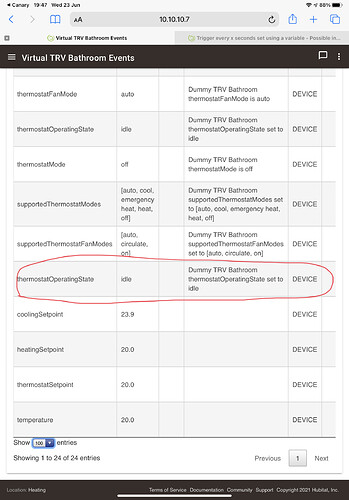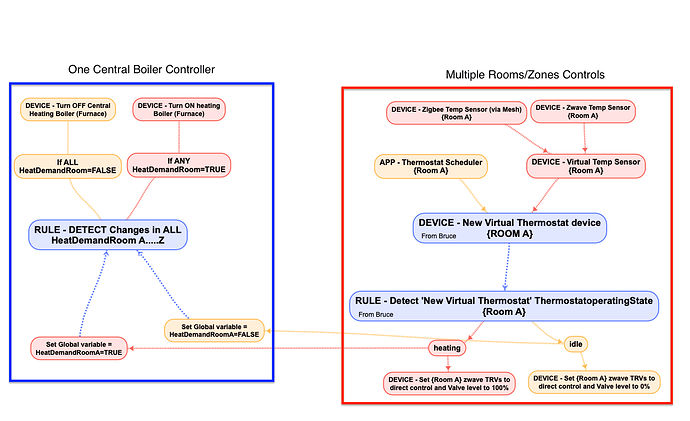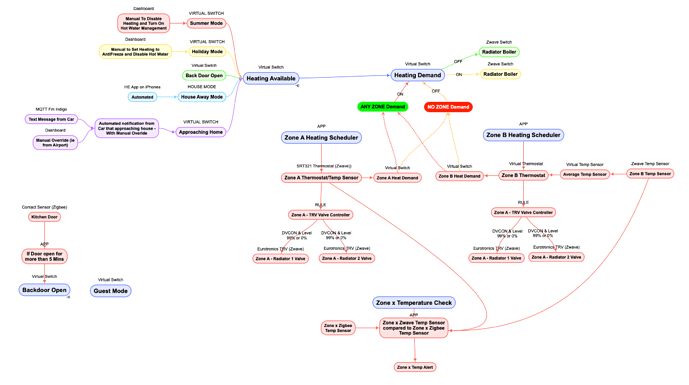You don't need to. If you're using a rule fired by thermostat operating state, this virtual thermostat will send out those events for you to trigger those rules. For instance, it will set the operating state to "heating" or "idle" as indicated by the setpoint and the temperature.
All you have to do is use Average Temp app to set the temperature from your sensors. Below is a modified version of that app that allows you to select the virtual thermostat to push temperature into. That's all there is to it.
definition(
name: "Average Temperatures",
namespace: "hubitat",
author: "Bruce Ravenel",
description: "Average some temperature sensors",
category: "Convenience",
iconUrl: "",
iconX2Url: "")
preferences {
page(name: "mainPage")
}
def mainPage() {
dynamicPage(name: "mainPage", title: " ", install: true, uninstall: true) {
section {
input "thisName", "text", title: "Name this temperature averager", submitOnChange: true
if(thisName) app.updateLabel("$thisName")
input "averageDev", "capability.thermostat", title: "Select virtual thermostat", submitOnChange: true
input "tempSensors", "capability.temperatureMeasurement", title: "Select Temperature Sensors", submitOnChange: true, required: true, multiple: true
paragraph "Enter weight factors and offsets"
tempSensors.each {
input "weight$it.id", "decimal", title: "$it ($it.currentTemperature)", defaultValue: 1.0, submitOnChange: true, width: 3
input "offset$it.id", "decimal", title: "$it Offset", defaultValue: 0.0, submitOnChange: true, range: "*..*", width: 3
}
input "useRun", "number", title: "Compute running average over this many sensor events:", defaultValue: 1, submitOnChange: true
if(tempSensors) paragraph "Current sensor average is ${averageTemp()}°"
if(useRun > 1) {
initRun()
if(tempSensors) paragraph "Current running average is ${averageTemp(useRun)}°"
}
}
}
}
def installed() {
initialize()
}
def updated() {
unsubscribe()
initialize()
}
def initialize() {
// def averageDev = getChildDevice("AverageTemp_${app.id}")
// if(!averageDev) averageDev = addChildDevice("hubitat", "Virtual Temperature Sensor", "AverageTemp_${app.id}", null, [label: thisName, name: thisName])
averageDev.setTemperature(averageTemp())
subscribe(tempSensors, "temperature", handler)
}
def initRun() {
def temp = averageTemp()
if(!state.run) {
state.run = []
for(int i = 0; i < useRun; i++) state.run += temp
}
}
def averageTemp(run = 1) {
def total = 0
def n = 0
tempSensors.each {
def offset = settings["offset$it.id"] != null ? settings["offset$it.id"] : 0
total += (it.currentTemperature + offset) * (settings["weight$it.id"] != null ? settings["weight$it.id"] : 1)
n += settings["weight$it.id"] != null ? settings["weight$it.id"] : 1
}
def result = total / (n = 0 ? tempSensors.size() : n)
if(run > 1) {
total = 0
state.run.each {total += it}
result = total / run
}
return result.toDouble().round(1)
}
def handler(evt) {
// def averageDev = getChildDevice("AverageTemp_${app.id}")
def avg = averageTemp()
if(useRun > 1) {
state.run = state.run.drop(1) + avg
avg = averageTemp(useRun)
}
averageDev.setTemperature(avg)
log.info "Average sensor temperature = ${averageTemp()}°" + (useRun > 1 ? " Running average is $avg°" : "")
}











